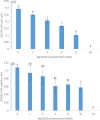Antibacterial effects of carbon dots in combination with other antimicrobial reagents
- PMID: 28934346
- PMCID: PMC5608398
- DOI: 10.1371/journal.pone.0185324
Antibacterial effects of carbon dots in combination with other antimicrobial reagents
Abstract
This study was designed to investigate the antimicrobial effects of CDots in combination with other antimicrobial reagents, including H2O2, Na2CO3, and AcOH (acetic acid). CDots were synthesized and passivated with 2,2'-(ethylenedioxy)bis(ethylamine) (EDA). The minimal inhibitory concentration (MIC) of CDots was 64 μg/mL on both Gram negative bacteria E.coli cells and Gram positive bacteria Bacillus subtilis cells. When CDots were combined with H2O2, antibacterial synergistic effects were observed based on the fractional inhibitory concentration (FIC) index, and further confirmed by an isobologram analysis and viable cell number counting methods. With the combination treatment of 10 μg/mL CDots with 8.82 mM H2O2, the viable E.coli cell numbers decreased 2.46 log, which was significant lower than the log reduction from 8.82 mM H2O2 (1.57 log) or 10 μg/mL CDots (0.14 log) treatment alone. However, the combination of CDots with Na2CO3 or AcOH did not show synergistic effects, instead, exhibiting indifference effects according to the FIC index. This study indicated that the combination of CDots with their synergistic antimicrobial reagents, such as H2O2, could reach the goal of inhibiting bacteria growth by using lower concentration of each individual chemical in the combination than using one chemical treatment alone, reduce the risks imposed on environmental health and the possibilities of the development of microbial resistances.
Conflict of interest statement
Figures







Similar articles
-
Synergistic photoactivated antimicrobial effects of carbon dots combined with dye photosensitizers.Int J Nanomedicine. 2018 Nov 27;13:8025-8035. doi: 10.2147/IJN.S183086. eCollection 2018. Int J Nanomedicine. 2018. PMID: 30568443 Free PMC article.
-
The dominant role of surface functionalization in carbon dots' photo-activated antibacterial activity.Int J Nanomedicine. 2019 Apr 23;14:2655-2665. doi: 10.2147/IJN.S200493. eCollection 2019. Int J Nanomedicine. 2019. PMID: 31118606 Free PMC article.
-
Nanocomposite of Ag nanoparticles and catalytic fluorescent carbon dots for synergistic bactericidal activity through enhanced reactive oxygen species generation.Nanotechnology. 2020 Oct 2;31(40):405704. doi: 10.1088/1361-6528/ab996f. Epub 2020 Jun 4. Nanotechnology. 2020. PMID: 32498056
-
Visible Light-Activated Carbon Dots for Inhibiting Biofilm Formation and Inactivating Biofilm-Associated Bacterial Cells.Front Bioeng Biotechnol. 2021 Nov 18;9:786077. doi: 10.3389/fbioe.2021.786077. eCollection 2021. Front Bioeng Biotechnol. 2021. PMID: 34869296 Free PMC article.
-
Synthesis, characterization and evaluation of antimicrobial and cytotoxic activities of biogenic silver nanoparticles synthesized from Streptomyces xinghaiensis OF1 strain.World J Microbiol Biotechnol. 2018 Jan 5;34(2):23. doi: 10.1007/s11274-017-2406-3. World J Microbiol Biotechnol. 2018. PMID: 29305718 Free PMC article.
Cited by
-
Citric acid/β-alanine carbon dots as a novel tool for delivery of plasmid DNA into E. coli cells.Sci Rep. 2021 Dec 14;11(1):23964. doi: 10.1038/s41598-021-03437-y. Sci Rep. 2021. PMID: 34907242 Free PMC article.
-
Engineering archaeal membrane-spanning lipid GDGT biosynthesis in bacteria: Implications for early life membrane transformations.mLife. 2025 Mar 13;4(2):193-204. doi: 10.1002/mlf2.70001. eCollection 2025 Apr. mLife. 2025. PMID: 40313982 Free PMC article.
-
Synergistic photoactivated antimicrobial effects of carbon dots combined with dye photosensitizers.Int J Nanomedicine. 2018 Nov 27;13:8025-8035. doi: 10.2147/IJN.S183086. eCollection 2018. Int J Nanomedicine. 2018. PMID: 30568443 Free PMC article.
-
Antibacterial Properties of Citric Acid/β-Alanine Carbon Dots against Gram-Negative Bacteria.Nanomaterials (Basel). 2021 Aug 6;11(8):2012. doi: 10.3390/nano11082012. Nanomaterials (Basel). 2021. PMID: 34443843 Free PMC article.
-
Antimicrobial Nanogels with Nanoinjection Capabilities for Delivery of the Hydrophobic Antibacterial Agent Triclosan.ACS Appl Polym Mater. 2020 Dec 11;2(12):5779-5789. doi: 10.1021/acsapm.0c01031. Epub 2020 Nov 11. ACS Appl Polym Mater. 2020. PMID: 33345194 Free PMC article.
References
-
- Joller N, Weber SS, Muller AJ, Sporri R, Selchow P, Sander P, et al. Antibodies protect against intracellular bacteria by Fc receptor-mediated lysosomal targeting. Proc Natl Acad Sci U S A. 2010;107(47):20441–6. doi: 10.1073/pnas.1013827107 ; PubMed Central PMCID: PMC2996673. - DOI - PMC - PubMed
-
- Mu H, Tang J, Liu Q, Sun C, Wang T, Duan J. Potent Antibacterial Nanoparticles against Biofilm and Intracellular Bacteria. Scientific reports. 2016;6:18877 doi: 10.1038/srep18877 ; PubMed Central PMCID: PMC4700437. - DOI - PMC - PubMed
-
- Singh VV, Jurado-Sanchez B, Sattayasamitsathit S, Orozco J, Li JX, Galarnyk M, et al. Multifunctional Silver-Exchanged Zeolite Micromotors for Catalytic Detoxification of Chemical and Biological Threats. Adv Funct Mater. 2015;25(14):2147–55. doi: 10.1002/adfm.201500033 - DOI
-
- Sun HJ, Gao N, Dong K, Ren JS, Qu XG. Graphene Quantum Dots-Band-Aids Used for Wound Disinfection. ACS nano. 2014;8(6):6202–10. doi: 10.1021/nn501640q - DOI - PubMed
-
- Sun YP, Zhou B, Lin Y, Wang W, Fernando KA, Pathak P, et al. Quantum-sized carbon dots for bright and colorful photoluminescence. J Am Chem Soc. 2006;128(24):7756–7. doi: 10.1021/ja062677d . - DOI - PubMed
MeSH terms
Substances
Grants and funding
LinkOut - more resources
Full Text Sources
Other Literature Sources
Medical
Miscellaneous

